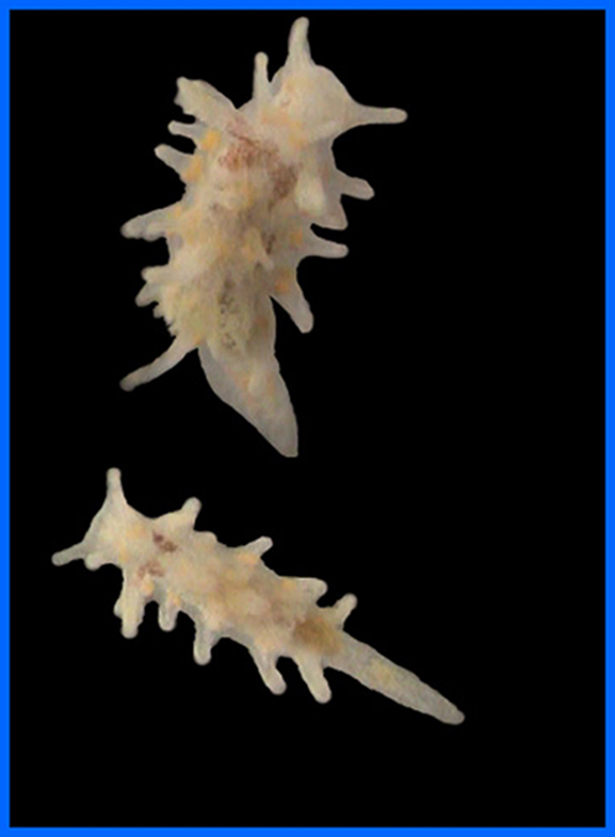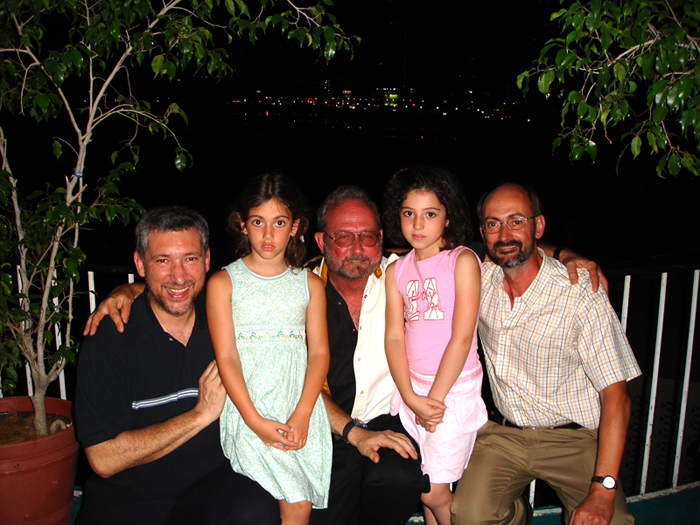 |
Photos courtesy of Francisco García and Jesús Troncoso
Okenia evelinae
Okenia evelinae Marcus, 1957
This tropical west Atlantic species occurs from Biscayne Bay, southern Florida (Marcus & Marcus, 1970) to São Paulo, Brazil, with intermediate collections from Puerto Rico and Venezuela (García, Domínguez & Troncoso, 2008). The original material was collected at 14 km west of Ubataba (22 slugs) and one at Ilhabela. García et al. present maps of these locations, and a description of the oceanographic conditions at Ilhabela.
“External Anatomy. The mantle is surrounded by enlarged papillae, two between the rhinophores and six on each side of the dorsum. There is a papilla in the center of the dorsum, and three behind the gills. The long rhinophores have 5-6 lamellae. There are six unipinnate gills. The tail is long, and the foot's posterior is rounded.
“Color. Body whitish or yellowish. The cephalic region, oral tentacles and dorsal papillae are translucent white; there is yellow pigmentation on the anterior border of the head and around the base of the dorsal papillae. Between the dorsal tentacles there are irregular chestnut-brown (reddish-brown) splotches. The rhinophores are purple from the base up to the lower lamellae; the rest is yellow. Gill rachis chestnut-brown, plumes whitish. The sides of the body have elongate yellow markings which extend to the tail.
“Internal Anatomy. The inner radular tooth has a thick cusp, with 13-20 rounded denticles on the inner face. The outer tooth terminates in two elongate cusps” (García, Domínguez & Troncoso, 2008: 104-105; translation from the Spanish by H.B.).
Marcus (1957) gave the radular formula as 28 (1.1.0.1.1), with 15-17 denticles on the inner side of each inner tooth.
Although Clark (1984), Valdés & Ortea (1995) et al. have synonymized this species with Okenia zoobotryon (Smallwood, 1910), O. evelinae is quite distinct and now regarded as such (cf. Valdés, Hamann, Behrens & DuPont, 2006). Clark (1984: 95) wrote, “differs only in color of the rhinophores (purple) and size and number of rows of radular teeth, which may be due to variations in diet and size,” to justify synonymization of these species. They are actually differentiating characteristics! Moreover, inter-specific niche partitioning is shown by their feeding specificity: O. evelinae feeds on the arborescent bryozoan Amathia convoluta Lamouroux, 1841, whereas O. zoobotryon eats the spaghetti-ish Zoobotryon verticellaltum (Delle Chiaje, 1816). Species of the families Goniodorididae and Polyceratidae are known to feed on various types of bryozoans. Interesting, in the Sea of Cortez, the polyceratid Polycerella glandulosa Behrens & Gosliner, 1988, also feeds on Zoobotryon.
Further information on Brazilian opisthobranchs (including a photograph of a Marcus-collected specimen of Okenia evelinae in the Museo de Zoología de la Universidad de São Paulo)
can be found in the new book,
Opistobranquios de Brasil : Descripción y distribución de
opistobrancquios del litoral de Brasil y del Archipiélago Fernando de Noronha.
Literature Cited
Clark, Kerry B.
1984. New records and synonymies of Bermuda Opisthobranchs (Gastropoda). The Nautilus 98 (2): 85-97.
García García, Francisco J., Marta Domínguez Álvarez & Jesús S. Troncoso
2008. Opistobranquios de Brasil: Descripción y distribución de opistobranquios del litoral de Brasil y del Archipiélago Fernando de Noronha. Feito, S.L., Vigo, Spain. 215 pp.
Marcus, Ernsto
1957. On Opisthobranchia from Brazil (2). Journal Linnean Society of London 43 (292): 390-486.
Marcus, Ernst & Eveline du Bois-Reymond Marcus
1970. Opisthobranchs from Curaçao and faunistically related regions. Studies on the Fauna of Curaçao and Other Caribbean Islands 33 (122): 1-129.
Valdés, Ángel, Jeff Hamann, David W. Behrens & Anne DuPont
2006. Caribbean sea slugs: A field guide to the opisthobranch mollusks from the tropical northwestern Atlantic. Sea Challengers Natural History Books, Etc., Gig Harbor, Washington. vii + 289 pp.
Valdés, Ángel & Jesús Ortea
1995. Revised taxonomy of some species of the genus Okenia Menke, 1830 (Mollusca: Nudibranchia) from the Atlantic Ocean, with the description of a new species. The Veliger 38 (3): 223-234.
Hans Bertsch, Francisco García & Jesús Troncoso

From left to right, Jesús Troncoso, Elena García, Hans Bertsch, Alexia Troncoso and Francisco García. The proud papas switched daughters!
Colleagues and friends, Hans, “Paco,” and Jesús have jointly attended international CLAMA (Congreso Latino-Americano de Malacología) conferences in Ensenada, Baja California, México, and Panamá. Based in Spain, “Paco” and Jesús have also conducted extensive fieldwork in Brazil and the Caribbean. They may be reached at: “Paco” (Catedrático, Universidad Pablo Olavide, Sevilla) fjgargar@upo.es and Jesús (Profesor Titular, Universidad de Vigo) troncoso@uvigo.es . Hans, of course (Profesor Permanente Invitado, Universidad Autónoma de Baja California Sur, La Paz), is still at hansmarvida@sbcglobal.net .
